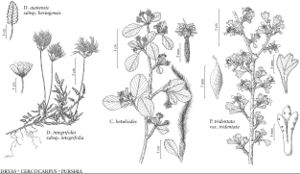Dryas
Sp. Pl. 1: 501. 1753.
Gen. Pl. ed. 5, 220. 1754.
Shrubs, tufted or matted, scapose, 0.1–2.3 dm; caudices relatively long, woody. Stems 3+, branched, rooting freely; bark green in 1st year, reddish to brown in 2d year, often appearing blackish, peeling; short and long-shoots absent; stoloniferous branches horizontal, relatively short, glabrous. Leaves persistent, simple or (in D. drummondii) basal leaflets 1 (–2); stipules persistent, narrowly lanceolate, margins usually entire, sometimes 1–2-toothed; petiole present; blade elliptic, lanceolate, linear, oblong, oblongelliptic, obovate, oval, or ovate, 0.2–3.9 (–4.6) cm, smooth to rugose or plicate, margins usually flat, sometimes revolute, crenate, dentate, serrate, or entire, abaxial surface tomentose or woolly, adaxial usually glabrous, sometimes tomentose or sparsely hairy on proximal portion of midvein. Inflorescences terminal, flowers solitary; bracts absent; bracteoles absent. Pedicels present. Flowers 13–29 mm diam.; hypanthium saucer-shaped, 3–15 mm, exterior villous, stipitate-glandular; sepals 8–10, ascending to spreading, linear-oblong or linear-lanceolate to lanceolate, elliptic, or ovate; petals 8–10 (–12), deciduous or persistent, usually white or cream, sometimes yellow, ovate to obovate, oblanceolate, or ovoid; stamens 50–130, shorter than petals; torus hemispheric; carpels 60–150, sessile, stigmas lateral. Fruits aggregated achenes, 20–40, linear to lanceolate, 0.8–3.5 mm, smooth with many short white hairs; hypanthium persistent; sepals persistent, erect-ascending. x = 9.
Distribution
North America, Eurasia, arctic, boreal, and alpine regions
Discussion
Species 15 (7 in the flora).
Hybridization is common in Dryas (E. Hultén 1959b), often rendering specimen identification difficult when based on morphological features. Molecular evidence indicates that there are multiple morphologically similar species within the broad concept of D. octopetala (R. Elven et al., unpubl.). A study of amplified fragment length polymorphism (AFLP) markers found D. drummondii to be sister to all other species of the genus (I. Skrede et al. 2006). The taxonomy in the present treatment is based on that in the Pan-arctic Flora (R. Elven et al., http://nhm2.uio.no/paf/) and reflects the findings by Skrede et al. that AFLP markers support various proposals of B. A. Jurtzev (1984) and refute some of those by Hultén.
Species of Dryas are among the important components of arctic and alpine tundra in terms of biomass (I. Skrede et al. 2006) and cover. Dryas has been placed in Dryadeae, which comprises four (Frankia association) actinorhizal genera, also including Cercocarpus, Chamaebatia, and Purshia (D. Potter et al. 2007). Dryas octopetala in the broad sense is characteristically a pioneer (T. T. Elkington 1971); it forms ectomycorrhizal associations with Hebeloma alpinum (J. Favre) Bruchet (Cortinariaceae, Agaricales), Cenococcum geophilum Fries (Ascomycetae, familial relationship unknown), and other fungi (M. Gardes and A. Dahlberg 1996). Nitrogen fixation occurs in root nodules of D. drummondii, D. integrifolia, and D. octopetala (in the broad sense) (D. B. Lawrence et al. 1967). The authors have observed root nodules on D. ajanensis subsp. beringensis. Soils in primary successional environments with D. drummondii have higher nitrogen and phosphorus, which facilitates growth of spruce seedlings (F. S. Chapin III et al. 1994). In late successional stages, D. drummondii is inhibited by alders by shading and from (possible) allelopathic effects (Chapin et al.).
In the key and descriptions below, feathery hairs, referred to by some authors as “octopetala scales,” consist of relatively thick brown axes bearing delicate white hairs, appearing featherlike (E. Hultén 1959b). The brown 'axes' of Hultén are analogous to a feather rachis. Such hairs may be absent from rare individuals in species that normally have them. Normally glandular species may include rare eglandular individuals.
Selected References
None.
Lower Taxa
Key
| 1 | Petals yellow, erect; leaf blades: bases usually cuneate (sometimes truncate or cordate); basal leaflets 1(–2); leaf surfaces tomentose; flowers nodding at flowering; filaments hairy. | Dryas drummondii |
| 1 | Petals usually white or cream, sometimes yellow, spreading; leaf blades: bases usually truncate or cordate, sometimes cuneate or rounded; basal leaflets 0; leaf abaxial surfaces tomentose to woolly, adaxial glabrous or glabrate, sometimes tomentose; flowers erect at flowering; filaments glabrous | > 2 |
| 2 | Leaf blades: margins usually entire or dentate to crenate, sometimes serrate in proximal 1/2; (plants eglandular). | Dryas integrifolia |
| 2 | Leaf blades: margins serrate to crenate or dentate (sometimes almost pinnatifid); (plants usually glandular, sometimes eglandular) | > 3 |
| 3 | Feathery hairs usually present, especially abaxially on midveins | > 4 |
| 3 | Feathery hairs usually absent, rarely 1+ feathery hairs abaxially on midveins in D. hookeriana and D. incisa | > 5 |
| 4 | Feathery hairs and stipitate glands abundant along midveins abaxially; nw North America. | Dryas ajanensis |
| 4 | Feathery hairs and stipitate glands scattered to rare along midveins abaxially; e Greenland. | Dryas octopetala |
| 5 | Leaf blades: sinuses of margins 45–60% to midvein, apices rounded to obtuse, surfaces smooth to rugose, plicate (midvein and lateral veins adaxially sunken into folds). | Dryas alaskensis |
| 5 | Leaf blades: sinuses of margins 5–30% to midvein, apices acute to slightly obtuse, surfaces smooth to rugulose or slightly plicate, (margins strongly revolute to flat, only midvein ± obscured adaxially within fold) | > 6 |
| 6 | Midveins and petioles not stipitate-glandular abaxially. | Dryas incisa |
| 6 | Midveins and petioles stipitate-glandular abaxially. | Dryas hookeriana |
"thin" is not a number.
